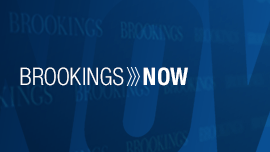Brookings experts were busy in September and there are several new podcasts, reports, and books to show for it. Here is a short list of just 10 things we learned from scholars’ research in the previous month.
1. Brookings experts’ reactions to Trump’s speech at the United Nations General Assembly

On September 25, President Trump delivered an address to the United Nations General Assembly. More than 20 Brookings scholars responded by annotating the president’s speech and providing their commentary and, in some cases, corrections to his remarks. Read their analysis in “Brookings experts on Trump’s UNGA speech.”
2. How to adapt to a “new threat landscape”

In a report with Charles Call, Daniel Toubolets, and Jason Fritz, Bruce Jones explored the modern threat and security landscape around the world, and what emerging threats merit the United Nations and other international actors’ attention. According to the authors, “frontier threats in emerging technology, and specifically cyber tools and artificial intelligence, pose an imminent and growing challenge to global security.”
In a related episode of the Brookings Cafeteria podcast, Jones discussed the report and whether the United Nations has the tools it needs to address these security challenges.
3. What challenges remain for meeting the United Nations Sustainable Development Goals?

In another paper released in advance of the United Nations General Assembly, Homi Kharas, John McArthur, and Krista Rasmussen considered how many people are being left behind in the efforts to achieve the UN’s Sustainable Development Goals by 2030. As part of their report, the authors examined which countries and regions will miss targets if current trends persist, noting, among other things, that “independent of population size, countries like Central African Republic, Chad, South Sudan, and Somalia will be furthest from the absolute targets in 2030.”
4. Bernanke, Geithner, and Paulson’s thoughts on the government’s response to the financial crisis

Throughout September, experts from across and outside Brookings reflected on the government’s response to the financial crisis of 2007-2009, highlighted by a series of events hosted by the Hutchins Center on Fiscal and Monetary Policy and the Program on Financial Stability at the Yale School of Management. In one of several noteworthy panel discussions, former Federal Reserve Chairman Ben Bernanke and former Treasury Secretaries Tim Geithner and Hank Paulson, three of the architects of the government’s response to the financial crisis, discussed the most challenging parts of the recession and the reasoning behind the decisions they made while in office.
Watch a full recording of their conversation or read a summary of the event written by Jeffrey Cheng and David Wessel. Ben Bernanke also authored a new report on the consequences of the crisis titled “The real effects of the financial crisis.”
5. The financial crisis’ long-term impact on teachers

In a new report, Mike Hansen, director of the Brown Center on Education Policy, analyzed what effect the Great Recession had on teachers’ age, qualifications, and compensation. He found that teachers are more qualified now than they were in 2007—both with respect to age and educational attainment—yet teachers’ wages overall have fallen, and by a greater amount than Hansen had formerly believed.
6. The global economic recovery has been uneven

Eswar Prasad and Karim Foda focused their latest report on how advanced and emerging markets have recovered from the economic crisis and specifically on several disconnects between economic markers and economic performance. “While a great deal of progress has been made in repairing financial and labor markets” they wrote, “the limited and incomplete nature of structural reforms in many economies leaves open the possibility that financial pressures and macroeconomic stresses could be lurking under the surface.”
7. Embracing a new partnership between cities, states, and the federal government

Amy Liu, vice president and director of the Metropolitan Policy Program at Brookings, wrote on the limits of city power in a recent piece for CityLab and, citing Sherrilyn Ifill of the NAACP Legal Defense Fund, warned that “local control” can give way to dangerous and oppressive policies that have led to racial segregation and voter suppression. Liu rejected the notion that cities and city leaders should “go it alone” in the age of Trump, and instead proposed a more constructive partnership between all levels of government with an emphasis on the role of cities.
This November, voters will go to the ballot box to choose new governors, state legislators, and members of Congress. It’s time to reset the federal, state, and local dynamic. While cities alone can’t save us, they can be the foundation on which we build a restored democracy.
8. Who is responsible for addressing the ethical dilemmas of artificial intelligence?

In a pair of papers from the Governance Studies program, Darrell West and William Galston examined the ethical dilemmas of artificial intelligence and the role government and corporations should play in addressing them. Each focused on a number of issues including weapons and surveillance and introduced the types of regulations they recommend for moving forward.
9. Rural areas could be bouncing back in terms of economic growth

According to Mark Muro and Jacob Whiton, employment growth rates of smaller, rural communities have outpaced national rates so far this year, a trend which could be good news for Republicans going into November. They analyzed what they call “modest but real reversal of fortunes in small town and rural America” marked by an increasing share of the nation’s job growth.
10. What progress has been made 50 years since the Kerner Commission report?

Marcus Casey and Bradley Hardy reflect on progress made since the Kerner Commission was authorized under President Lyndon B. Johnson to study the causes of riots 50 years ago, and specifically, what change has occurred in four cities: Detroit, Los Angeles, Newark, and Washington DC. The authors found the neighborhoods that directly experienced riots in 1970 shared several traits—lower levels of education and higher unemployment among them—than other neighborhoods that had not directly experienced riots and that these differences between the two neighborhood groups have persisted over time.
You can find their full report, “The Evolution of Black Neighborhoods Since Kerner,” in the Russell Sage Journal of the Social Sciences.
Megan Drake contributed to this blog post.
The Brookings Institution is committed to quality, independence, and impact.
We are supported by a diverse array of funders. In line with our values and policies, each Brookings publication represents the sole views of its author(s).


Commentary
10 things we learned at Brookings in September
October 2, 2018